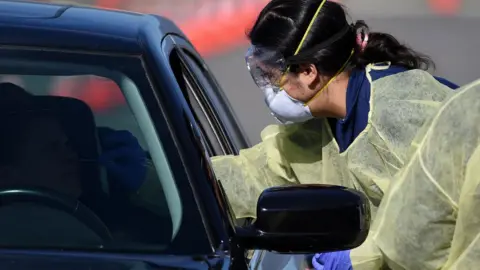Coronavirus: Five Trump claims fact-checked
 Getty Images
Getty ImagesPresident Donald Trump has been defending his handling of the coronavirus outbreak as the number of cases there continues to rise sharply.
We've fact-checked some of the president's recent claims.
Claim 1
"The United States has done far more 'testing' than any other nation, by far!"
Mr Trump said this on 25 March, when the latest official data showed that a total of 418,810 people had been tested in the US.
Figures from South Korea for that date show a total of 357,896 tests. Before that, South Korea had conducted more tests than anyone else.
So the US has carried out more tests in total, but what's important is that South Korea has a population of about 51 million, compared with the US which has about 328 million.
Therefore, by 25 March the US had tested around one in 780 people, compared with South Korea which had tested more than one out of every 150 people.
That's far fewer per capita in the US than in South Korea, and both countries detected their first case of Covid-19 on the same day in late January.
In early March, the White House conceded that the United States did not have enough testing kits and some health centres have also reported difficulties using them.
However, testing in the US has significantly ramped up recently, with the total number almost doubling in late March.
Claim 2
When asked about WHO data on the virus's death rate: "I think the 3.4% is really a false number... Personally, I think the number is way under 1%."
In a telephone interview on Fox News, President Trump said a WHO figure of 3.4% for the coronavirus death rate was "false". The WHO reported this figure on 3 March and said it was based on all the confirmed coronavirus cases that had resulted in death.
Mr Trump said he thought the true death rate, based on "my hunch", was "way under 1%". He said the death rate appeared higher because many people who caught a mild form of the virus did not report it to the doctor and therefore did not end up as confirmed cases.
At the moment we don't know how likely you are to die from coronavirus, mainly because of the lack of data on infections. However, scientists' current best guess is about 1%.

- EASY STEPS: How to keep safe
- A SIMPLE GUIDE: What are the symptoms?
- CONTAINMENT: What it means to self-isolate
- MAPS AND CHARTS: Visual guide to the outbreak

Claim 3
On 9 March: "Last year 37,000 Americans died from the common flu. Nothing is shut down, life and the economy go on... Think about that."
This statement from the president requires context. We don't know exactly how many American deaths there have been linked to flu. But estimates from the US Centers for Disease Control (CDC) give a range between 26,339 and 52,664 flu deaths last winter (between October 2019 and February 2020), with a best estimate of 34,157. So a lot of people die from flu each year, as Mr Trump points out.
However, unlike most strains of flu, the spread of the new coronavirus has not yet been contained by vaccines or immunity from previous outbreaks, and scientists (including those from the WHO) believe it has a significantly higher death rate than that of seasonal flu (which, on average, is about 0.1%).
 Karen Ducey
Karen DuceyClaim 4
On 7 March: "Very soon, we're going to come up [with a vaccine]."
Currently there is no vaccine for this new coronavirus, although scientists in many countries are working hard to develop one. Scientists say realistically, one won't be ready until at least the middle of next year. Testing of vaccines on animals has already started. There's also been a test on human volunteers of a vaccine against coronavirus, but it will take many months before we know if this works.
 EPA
EPAClaim 5
On 29 February: "We've taken the most aggressive actions to confront the coronavirus. They are the most aggressive taken by any country."
The US has now imposed sweeping restrictions and some quarantine measures. But other countries have also taken aggressive measures to counter the virus - in some instances, more than the US.
China and Italy, for example, introduced widespread quarantining, affecting millions of people. The EU has closed its external borders for at least 30 days, with some European states closing their borders to any non-nationals, as well as introducing severe restrictions on movement.



